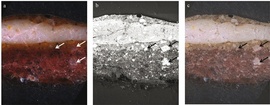 |
Date Announced: 09 Aug 2011
Art curators and conservators now can quickly get far more detailed information than ever before by using an integrated combination of light and electron microscopy.
OBERKOCHEN/Germany, NASHVILLE/Tennessee/USA, 09.08.2011. Carl Zeiss today announced that the Indianapolis Museum of Art (IMA) is using a Carl Zeiss “Shuttle & Find” Correlative Microscopy package in the museum’s new state-of-the-art conservation science laboratory funded by Lilly Endowment Inc.
The package facilitates direct communication between ZEISS electron microscopes and ZEISS light microscopes, thus significantly accelerating the examination of artwork samples. Each of these microscope types offers unique ways to examine and analyze paintings and other types of artwork.
The challenge is to be able to switch back and forth between these microscope types quickly and precisely. Thanks to the Carl Zeiss “Shuttle & Find” Correlative Microscopy package, the location of an area-of-interest identified within one instrument can be quickly and easily retrieved in the other instrument, making this approach a real solution for the first time. This very much broadens the range of applications and speeds the examination of artwork samples.
The “Shuttle & Find” package consists of software and hardware components, including a specialized specimen holder and adapters for the transfer of the specimen — in the application of the IMA usually a tiny sample of paint — from the light to the electron microscope and vice versa.
Along with the “Shuttle & Find” package, IMA has also installed an EVO MA 15 scanning electron microscope, an AXIOIMAGER M2m compound microscope, a DISCOVERY V20 stereomicroscope, and an OPMI Pico surgical microscope, all from Carl Zeiss. These instruments will update the museum’s long-serving ZEISS polarized light microscope that has been in service since the 1970s.
The laboratory, one of only a few such sophisticated conservation science labs in the world, answers materials analysis questions for curators and conservators, conducts technical analysis of artwork, and performs applied and basic scientific research into artists’ materials and techniques.
Microscopes play an integral role in the work of the conservation science laboratory, which uses a materials approach to art history, providing evidence of an artist’s materials or working methods, authenticating an artwork, or assisting in its attribution. Dr. Gregory Dale Smith, the museum’s Otto N. Frenzel III Senior Conservation Scientist, installed the Correlative Microscopy package into the new laboratory.
“The concept of performing our imaging work with trouble-free transfer of the sample from the light microscope to the electron microscope, and retrieval of the region of interest within seconds, intrigued me,” said Smith. “Only Carl Zeiss provides both light and electron microscopy platforms as well as the means to integrate them in this way.”
The “Shuttle & Find” interface enables the quick and easy relocation of the area of interest, fully utilizing the capabilities of the two complementary microscopy technologies. Traditional light microscopy permits a quick overview of the sample and a number of contrasting technologies (e.g. color, polarization, fluorescence, dark field / bright field).
However, there is a two orders-of-magnitude higher resolution available by means of the electron microscope, and it offers expanded analytical possibilities, such as energy dispersive x-ray spectroscopy (EDS) to characterize the sample´s chemical composition. Finally researchers can also accurately overlay the light microscopy image and the electron microscopy image by using the “Shuttle & Find” software package, providing complete information on the sample in one visual field.
“We at Carl Zeiss are pleased to be working with the professional team of museum scientists, conservators, and curators at the Indianapolis Museum of Art,” said Dan McGee, President of Carl Zeiss NTS, LLC. “It’s genuinely rewarding to help develop newer, faster ways to get accurate answers to some of the art world’s more perplexing questions.”
Source: Carl Zeiss
E-mail: via web site
Web Site: www.zeiss.de/corrmicforma
| © 2026 SPIE Europe |
|